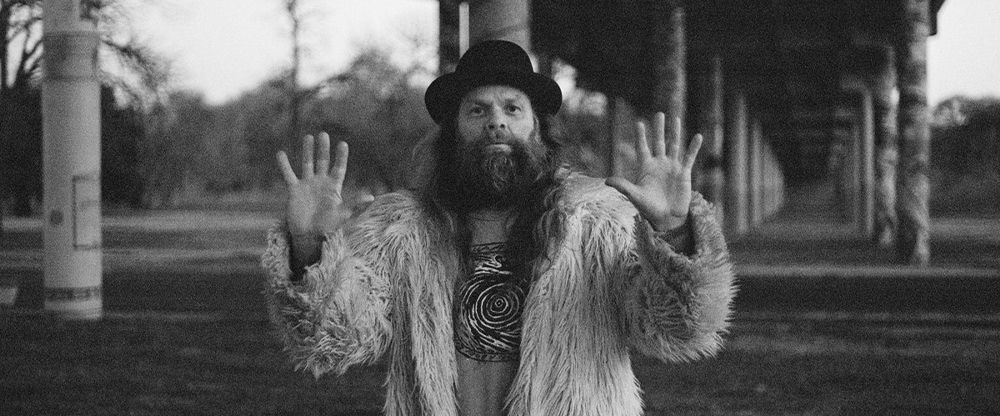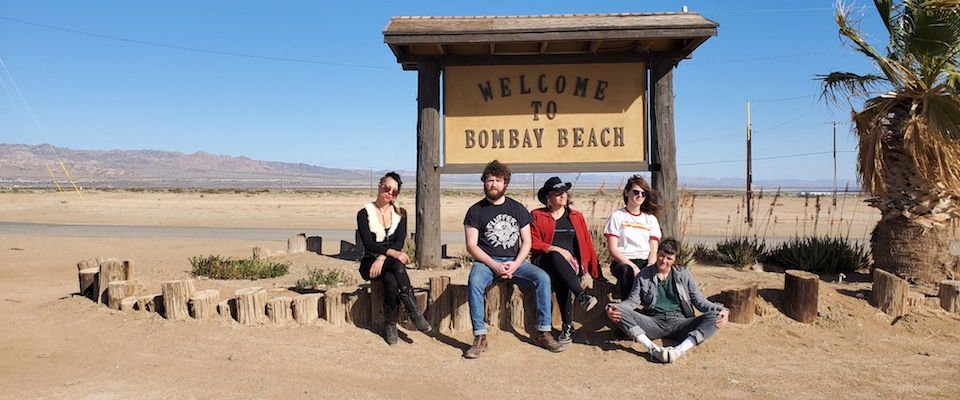Musical Context
The other day, I was driving home, listening to my KUTX colleague Ryan Wen. He hit an inspired segue, the kind that all DJs slobber over: Can’s “Vitamin C” into Black Star’s “Definition.” Jaki Liebezeit’s kick pedal sounded like distant artillery strikes, setting up the percussive explosion from Talib Kweli and Mos Def. Pure bliss.
I’ve heard each of these songs dozens of times, but never back-to-back. The segue created a new pathway in my brain, and now these songs are tethered together in a wholly unique way. How can these songs suddenly sound so new to my ears, simply by existing next to each other?
For most of my adult life, there’s been a lot of talk about the death of the album and the death of radio, and even right now a possible death of the concert is floating around. But each of these mediums provide something so crucial to music: context. Like us humans, songs seem to fit best in a network of mutuality, where they play off of and enhance the other songs around it. For me, a good song can work well on its own, but it’s taken to some higher realm when slotted next to something that brings out its best qualities or throws off some different kind of light.
Songs are not objects or products because they aren’t static. They change over time and space. Hearing “Vitamin C” on a beautifully sunny winter day in the car with my daughter is different from when I first discovered it or played it on my own radio show. It’s different every time I hear it, which means, depending on the context, its possibilities are limitless.
We crave not just context, but meaningful context, where there’s a human heart and story and sense behind the meaning. An algorithm can only hit this randomly. It could be programmed to pick this same segue because the two songs are rhythmically linked, but that’s a shallow approximation of the artistic impulse. Ryan played these songs back-to-back because he heard something new in them together, and I heard it new with him, and we both leave the moment with something new in that friction. That’s an amazing thing, and these songs rule, and we should be putting songs in new contexts more often.

On ‘Doom Dub II,’ Austin’s Thor Harris Gives Doom A Dub Remix
Dub music is a paradox: it’s music made from the removal of music. In the late 1960s, Jamaican producers like Lee “Scratch” Perry, King Tubby, Augustus Pablo, and others began playing with the molecular structure of sound. Starting with full-band reggae recordings as source material, the producers remixed them, questioning the very materiality of the songs themselves. What happens when you silence the vocals and melodies, leaving just drums and bass for measure after measure? What happens if you run every sound through echo machines like the Roland Space Echo? You get something new, something both ancient and futuristic sounding. Dub producers could alchemize a song out of thin air, making it haunting, odd, transcendent, even hilarious—just like life itself. The space carved out by these pioneers birthed entire musical galaxies: there would be no electronic music or rap without dub.
Thor Harris doesn’t remember exactly how he first encountered dub music, but it irrevocably sent him on another orbit. The Austin musician spent his junior high and early high school years learning the drums by studying prog rock, one of the more complex and technically challenging forms of popular music. “There was nothing to do in the suburbs but practice music and ride my BMX bike,” he says. “So I listened to prog rock and tried to become a monster drummer as fast as I could. But then dub landed in my ears and it was love at first listen.”
Read more of my profile of the amazing, unclassifiable weirdo Thor Harris at KUTX.

Immersive Attention
These days I’m really enjoying Longform Editions, a label from Sydney, Australia that only releases longform music, i.e. really long songs. Each release is a single piece of music, ranging from twenty to sixty-plus minutes. The label has a wide genre focus: electronic, folk, jazz, experimental, all united by the same prompt. My personal favorites focus on texture and color, conjure up landscapes and maps, stick to highly specific parameters, or move at a walking pace. They all play with time as the primary musical material, so the music plays with me as a listener. My perception of passing time changes, and so do my expectations for instant gratification or trying to find the ‘point’ to the song. My body slows way down to meet the music on its own unyielding terms. The music isn’t strictly ambient. It’s just slow, and that slowness is immensely interesting.
Andrew Khedoori and Mark Gowing, Longform’s founders, were recent guests on Aquarium Drunkard’s Transmissions podcast (which shares a patient, deeply immersive ethos with the label). They talked about how they envisioned the label as an art gallery that offers space for the musicians to experiment and for listeners to spend some serious time with each piece. And that literal spending of time really fascinates me. Longform is a purely digital label, which means there are no physical products to worry about. For me, streaming’s inherent downside is I can’t interact with the music outside of scrolling and clicking. Everything is ephemeral, so everything can feel sealed off and meaningless. Without the ability to sell physical objects, streaming banks on my attention (note it’s always the quasi-violent goal of ‘capturing’ my attention).
But Longform’s music sidesteps this issue by requiring immersive attention as its price. Because of the long time commitment, I engage with an individual piece on a deeper level. If most of streaming is heading towards shorter and shorter songs and less attention spans, Longform goes the opposite way and makes something bigger, weightier. Immersive attention feels like both an economic model and a more alive way of being. When you’re immersively attuned to the music, you’re bringing your physicality to the experience. I suspect this completes some sort of needed circuit, which is why it feels so good.
Zeitgeist & Sound
Really loved this newsletter entry (post? Edition? What are we calling these things in this Newsletter Golden Age?) from Damon Krukowski. He’s a musician, critic, deep listener/thinker, and he tackles the thirtieth anniversary of Nirvana’s Nevermind from the perspective of a working musician who was on the road at the same time as Nirvana in the fall of 1991. Two things were happening simultaneously in Krukowski’s life at the time: Nirvana and alternative rock were climbing to the top of the pop charts; and jazz, classical, and “world” music were entering his life (and public consciousness) on a bigger scale. He explains how CD technology—with its uninterrupted, generous running time—and globalization worked together to put less-popular genres into stores alongside all those Nevermind copies. So for Krukowski, the “sound” of 1991 is Nirvana and Qawwali, Mozart, and improvisatory music.
I’m fascinated by these limits to defining the zeitgeist. Yes, Nirvana was immensely popular (or well on its way to becoming popular) in the fall of 1991, but other strands of music were just as alive. They’re hidden from view now for two reasons. The first I’ll call the hindsight reason: Nirvana undoubtedly influenced a whole generation of music and we can still feel the ripples, so we keep repeating the Nirvana Was Important tale to explain its colossal impact, to explain where we are today. It’s simple, it’s tidy, it helps us feel a shared history, even if you weren’t/aren’t a Nirvana fan.
The second reason is related to this simplification, and I’ll call it the blindsight reason: it’s hard—though Krukowski tries—to trace the impact all of this newfound access to jazz, classical, and world music had on the public. To the best of my knowledge, not too many Qawwali-influenced bands rose up in early ’90s America. Teenage music fans didn’t start dressing in wigs and tights in homage to Mozart. We don’t explicitly see the impact, so we write it off as an untidy anomaly, a footnote to Nirvana’s royal reign. If Nirvana was an asteroid smashing into the Pacific Ocean, this newfound access to jazz, classical, and world music made a pebble-sized splash. You could see it in the early ’90s, but you can only feel it now if you actually experienced it.
Yet jazz, classical, and world music were just different strands of a larger 1991 musical tapestry. I’m interested in these personalized, weirder pockets of music history because they can make an era feel much more lived and alive than just rehashing the same Nirvana Was King history. Life, in any era, is much weirder and more surprising than we can possibly imagine from our vantage point.
And it gets weirder the further you zoom in. There’s the culture you live in, then there’s your culture, the hyperspecific way you curate or are curated by different forces. You’re constantly discovering artists/genres outside of their particular zeitgeist, playing catch-up with a vast wealth of music history, and this can coincide with the dominant “sound” you live through. In 2008-2009, I discovered and got obsessed with ’70s krautrock, so for me that sound reminds me of that era, just as much as Beyonce, Kanye, and Daft Punk do. This is why I don’t lament the supposed end of the monoculture. I think it was an artificial myth to begin with. Plus, monocultures—like monoculture farming—are probably inherently unhealthy. Give me the wilder forests of personal zeitgeist.
Krukowski also includes a 1991 documentary about improvised music in his remembrance. In the beginning of the video clip, jazz musician Douglas R. Ewart teaches a Chicago grade school class about improvisation. The lesson starts off chaotic: Ewart blows into a didgeridoo, the kids bang randomly on peanut tins and desks with drum sticks, there are a lot of confused and bored faces. Then the music starts to congeal into a rhythmic pulse. Ewart starts shouting nonsense phrases, the students respond, the pulse quickens and slows, the music moves with a life of its own. Everyone is having fun.
Ewart, in voice over: “Usually I say nothing to them. I come in and I begin playing and then they begin playing, and we experiment from there…in most subjects in school, students individually synthesize the lesson. Here, they have to work together…it doesn’t matter if they’re the A student or the D student to me.”
Compare this with your own experience of early musical education: if you went to an American public school like me, you were immediately taught what was a wrong note. You were taught compliance and competition. You were taught there is a hierarchy, between first chair and last chair, between “noise” and music.
Doesn’t music education need to start from Ewart’s position? We should teach sound first as an infinite possibility—the basic building block of music—before we teach the correct notes to play. Sound and music start with the body: how we perceive, how we listen, how we play, how we interact.
Teach noisemaking because it’s fun. Teach past the boundaries of instruments. Teach the unique personal expression of everyone, and the way those expressions can combine into something bigger. Sound is a marvelous, miraculous thing, and we shouldn’t be afraid of using all of it.

The Secret Sounds Of Mushrooms: The Octopus Project Talks About Making Music With Mushroom Collaborators
Every living thing gives off electricity. It’s a fact that shouldn’t be buried in boring textbooks but displayed in gigantic, neon letters at the front of the classroom. When you learn that “every living thing gives off electricity,” it leaves you in awe, and your mind starts to make interesting connections, spreading like mycelium. Soon the next question arrives. “Cool. Then can mushrooms make music?”
Nature has inspired musicians for centuries, but recent history has proven to be a particularly fertile time. Experimental composer John Cage was a dedicated amateur mycologist, going so far as to publish a book of recipes, photos, and essays about the musicality of mushrooms in 1972. There’s also Mother Earth’s Plantasia, a 1976 album of childlike synthesizer music by Mort Garson that somewhat dubiously claimed to help your plants grow. And Stevie Wonder capped off the 1970s (and his chart-topping run of albums) with Journey Through The Secret Life Of Plants, a documentary soundtrack featuring ninety minutes of bizarre, electro-funk plant worship, all from the man who brought you “Sir Duke.”
But in 2021, musicians aren’t content with merely playing for plants—they’re playing with plants. The Octopus Project is no stranger to taking wonderful, science-adjacent ideas like these and running with them. The band—Yvonne Lambert, Josh Lambert, Toto Miranda, and Mari Rubio—is known for its wildly-creative live shows, like those for the 2010 album Hexadecagon, which featured eight loudspeakers surrounding the members while eight projectors showed videos synced to the music.
Like a fungal network, the band’s interest in mushrooms doesn’t have a definitive starting point, but the project first started sprouting in Peru in 2019. There, Yvonne and Josh met a friend who had a MIDI biodata sonification device, which measures electrical fluctuations through sensors attached directly to any living thing—plant, fungus, or otherwise. That data is then translated into MIDI notes, which can be played by a synthesizer or computer software. They drove around the Sacred Valley, home to Machu Picchu, and started testing the device on various plants, amazed at the possibilities opening before their ears. Yvonne and Josh quickly bought a sonification device as soon as they got back to Austin, and the process of playing music with mushrooms has been inspiring. “The sky’s the limit with this,” says Josh. “There’s a ton of stuff that can be mined from this idea.”
Read more of my fascinating interview with the Octopus Project at KUTX.

Making Music At The End Of The World
In late February 2020, Sheverb slammed through one more song in front of a rowdy crowd at the Ski Inn. The Austin band had traveled twelve hundred miles to make an album in the semi-abandoned Southern California town of Bombay Beach. For a month, the locals embraced the band members, shared meals, and danced to their songs. An impromptu, vibrant community grew around the music and art, like how a little bit of rain makes the desert bloom. Darker clouds loomed on the horizon.
The members of Sheverb packed up their instruments and squeezed into their van. “I remember downloading a bunch of podcasts on my phone to make the drive home,” says guitarist Betty Benedeadly. “And there was like all of these podcast headlines about a pandemic, and I was like, ‘Is this fucking real? What is going on?’” They had spent a month off the grid and now the grid was cruelly reasserting itself. February crept into March, the band settled back in Austin, and the pandemic moved in too, first shuttering South By Southwest, then the entire Austin music scene. “I remember those first few weeks being like, man, why the fuck didn’t we stay [in Bombay Beach]?” says Benedeadly. The last song of Sheverb’s last set at the Ski Inn is the last time the band has played together.
Read more of my profile of Sheverb, where I touch on the American West as both a utopian and apocalyptic landscape.